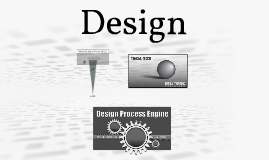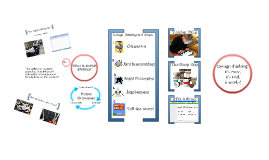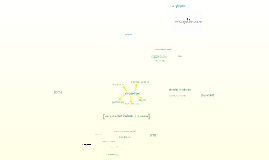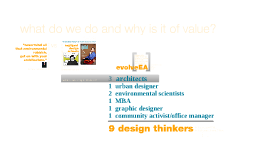Thinking Design Thinking
Transcript: Society has not defined design as we think of it until very recently in historical terms. The word design originated in the late 1500s from the Latin words “signare” which means to mark and from “de” which means out. “designare” to mark out and/or devise. Today, design is a term with broad and multiple meanings. Trying to define or describe it is difficult and can lead to confusion. Verb Design is an action and can be defined concisely as “to plan something” This implies that when one designs, one has a deliberate intention: to make, create, form, organize, and/or build with a specific function, purpose or outcome in mind Noun Design is the plans for something. That may be in the form of: 1) sketch 2) drawing 3) blueprint, 4) schematic with parameters/specifications, 5) flow chart 6) a road map for a strategic approach. Noun A Plan For Order Verb To Plan For Order The Architecture Of Design IS DESIGN DESIGN IS THE ARCHITECTURE OF ITSELF To study Design is to study how things are made & the processes that are used to make them We can study Visual Literacy & the Design Process Show Logos Movie Roger Martin who is the dean at The Rothman School of Management (UofT) "a way of approaching business problems in the same way that the designer approaches a design problem. At the heart of design thinking is the designer's unique work process, one that begins by fully understanding the problem before thinking about possible solutions. Set of steps or a process that can be followed to encourage the open and evolving solutions that are needed to solve complex and wicked problems." Charles Burnette in his IDeSiGN curriculum calls it, “…a process of creative and critical thinking that allows information and ideas to be organized, decisions to be made, situations to be improved, and knowledge to be gained.” Design thinking in Business: 1) Designers achieving innovative outputs or products (for example, the iPod) 2) Designers bringing their methods into business by either taking part themselves in business process, or training business people to use design methods Design thinking in education Design thinking in education typically takes three forms: 1) Helping school administrators solve institution based problems. 2) Aiding educators develop more creative lesson plans. 3) Engendering design thinking skills in students. Watch Wicked Problems Movie Definition of design thinking beginning 20th Design Communication (graphic design) Artifacts (industrial design). Close of 20th The design of interactions, (involving computers and other systems) Design skills applied to solving problems at the level of organisations and society. New term “design thinking”. The problems are not within designer's exclusive area as traditionally defined. Among other things, design thinking calls for reframing problems (how the problem is described) to find solutions that others have overlooked. Example In the 1950s, most people who were trying to speed up oceanic shipping were focused on the time it took to move cargo across the ocean. By improving the ship’s engines or the shape of its hull they were sometimes able to take hours or days off for each crossing. Malcolm McLean, owner of a trucking company, recast the problem to focus on the time it took to move cargo on and off ships. His innovation, container shipping, eventually reduced cargo’s total time in transit by weeks rather than hours or days. [1] Design thinking will encourage creativity in the classroom as well as in the boardroom, pushing students away from rote learning and the only possible answer into the realm of creative problem solving whereby multiple outcomes and possibilities are the only answer. Nigel Cross Noun A Plan For Something Verb To Plan Something also a design theorist What is DESIGN THINKING? 1a: a particular purpose held in view by an individual or group <he has ambitious designs for his son> 1b: deliberate purposive planning <more by design than by accident> 2: a mental project or scheme in which means to an end are laid down 3a: a deliberate undercover project or scheme <to plot> 3b: plural - aggressive or evil intent <he has designs on the money> 4: a preliminary sketch or outline showing the main features of something to be executed <the design for the new stadium> 5a : an underlying scheme that governs functioning, developing, or unfolding <Pattern, Motif> 5b : a plan or protocol for carrying out or accomplishing something <such as a scientific experiment> 6: the arrangement of elements or details in a product or work of art 7 : a decorative pattern <a floral design> Design Design is an interesting word Noun/Verb This may be the root of any confusion. What is Design? Design thinking not rote learning. "Design has its own distinct intellectual culture; its own designerly ‘things to know, its own ways of knowing them, and its own and ways of finding out about them" Noun Environments & Places Design Thinking: The next big thing in Design. Design thinking refers to

















